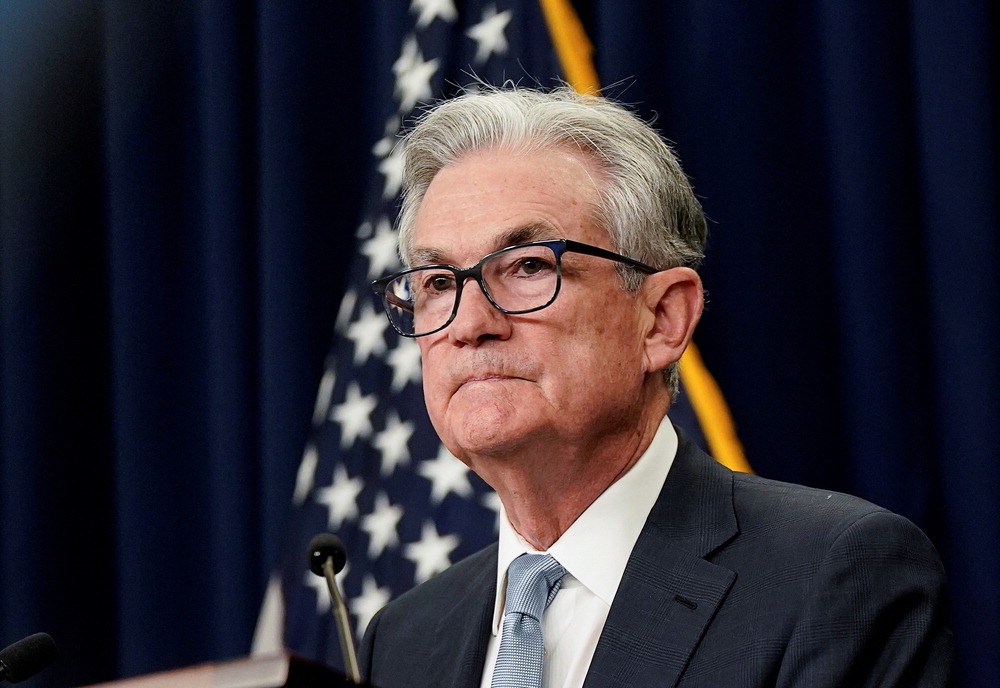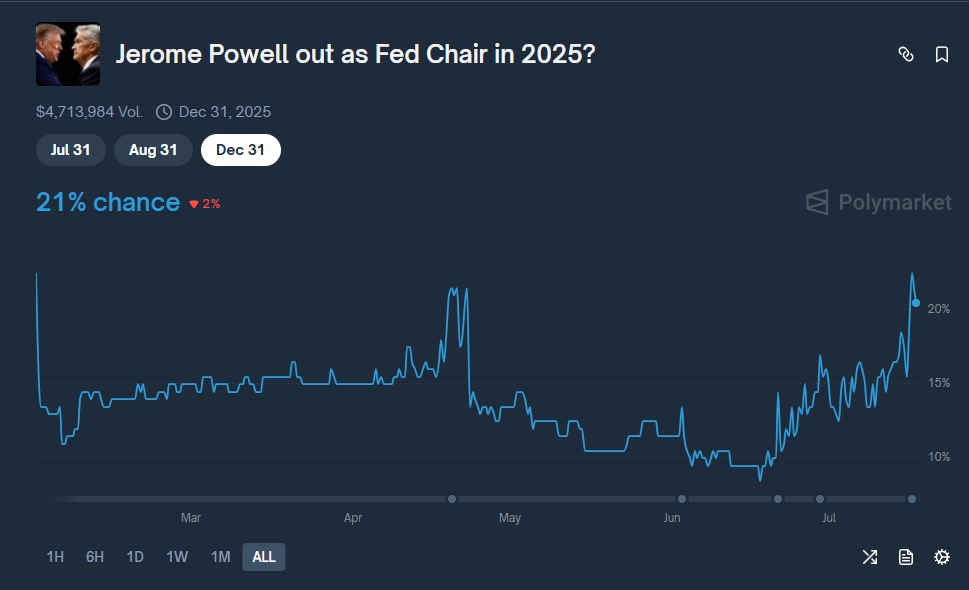Written by: Oliver, Mars Finance
In July 2025, the financial world split into two disconnected realities. On one side is the interest rate market, representing the traditional financial order, like a "rational fortress" built from cold data and century-old rules, calm and restrained; on the other side is the prediction market Polymarket, emerging from the crypto world, resembling a "chaotic stage" driven by crowd emotions and political storms, passionate and radical. They both point to a focal figure: Federal Reserve Chairman Jerome Powell. However, their predictions about Powell's future are diametrically opposed.

This profound divergence concerns not only the fate of a central bank governor but also represents a fundamental confrontation over information, power, and the future. The core question is: when a powerful political will attempts to shake the foundations of the financial system, what should we believe? The economic data and institutional inertia revered by Wall Street elites, or the crowd fervor and political brute force wagered by crypto world speculators? This is not just a contest of market predictions but a prism reflecting two entirely different cognitive systems and logical frameworks of our era.
The Birth of a Divergence: The Moment of Split Between Two Oracles
This significant divergence was ignited in early July. Prior to this, the interest rate market and Polymarket had a largely synchronized view of Powell's status, with clear and unified logical clues in the market. However, on July 2, Trump publicly called for Powell's resignation, a politically charged statement that was like a boulder thrown into a lake, instantly shattering the fragile consensus.
On the politically sensitive stage of Polymarket, the contract price for "Powell being dismissed in 2025" surged, with its implied probability rising rapidly from less than 15% to 22%. This speculative enthusiasm spread like wildfire in the digital world. However, in the interest rate market, which manages the flow of trillions of dollars globally, everything remained unusually calm, like a seasoned player facing a blustering opponent, unmoved.
The next day, July 3, the logic of the two markets completely diverged. The U.S. employment data released that day was stronger than expected, weakening the rationale for the Federal Reserve to significantly cut interest rates in the short term. Traders in the interest rate market quickly reacted by reducing their bets on rate cuts. On the same day, U.S. Treasury Secretary Scott Bessenet expressed a more moderate and cautious stance, which Wall Street interpreted as a "stabilizing anchor" from within the system. Thus, a peculiar scene emerged: Polymarket traders continued to bet that Trump's political will would ultimately prevail, while interest rate market traders chose to believe in the power of economic data and the institutional resilience of the financial system.
Some may ask, how can a 22% probability be considered "diametrically opposed"? This is the key to understanding this divergence. Here, "opposite" does not refer to the numerical opposition of 22% and 78%, but rather to the fundamental opposition in risk perception. In the interest rate market's model, forcibly dismissing a Federal Reserve chairman is a "black swan" event that could trigger a financial tsunami, with its occurrence priced at nearly zero (near-zero), a risk that can be ignored. In contrast, Polymarket's 22% (about one-fifth) probability for such a disruptive event appears extremely large. It implies that in a market where real money is at stake, a significant portion of people believe that this "black swan" event, capable of undermining financial stability, has a one in five chance of occurring. Therefore, the essence of this confrontation is the struggle between the "nearly zero" certainty and the "22%" enormous uncertainty, with their depicted risk realities being completely opposed and irreconcilable.
The Fortress of Rationality: How Wall Street Prices "High Probability"
To understand why the interest rate market exhibits such remarkable "immunity" to Trump's "dismissal" threat, one must delve into its internal operating mechanisms. This market is not a forum filled with emotional speculation but a "rational fortress" built from cold capital and complex mathematical models. One of its core tools is the CME's FedWatch tool. This tool's predictive ability does not stem from public opinion polls but directly from the trading prices of federal funds futures contracts, which amount to trillions in daily trading volume. When giants like JPMorgan or Goldman Sachs bet real money, their decision-making is based on rigorous macroeconomic analysis.
Recent strong employment data and persistent inflationary pressures are seen as core "signals" by traders in the interest rate market. These data clearly indicate that the fundamentals of the U.S. economy do not support an immediate shift to aggressive rate cuts by the Federal Reserve. Therefore, from a purely economic logic standpoint, regardless of whether Powell remains in office, any rational successor would face the same policy constraints. The market pricing reflects a belief that the gravitational pull of economic laws far outweighs the political push from the White House.
This belief is reinforced by key figures within the system. Treasury Secretary Bessenet's moderate statements cleverly transformed a potential political storm into a predictable, step-by-step administrative process. More importantly, Wall Street leaders also voiced clear opinions at this moment. JPMorgan CEO Jamie Dimon publicly stated that "the independence of the Federal Reserve is absolutely critical," warning that "playing with the Fed could have unintended negative consequences." This statement represents the consensus of the entire Wall Street establishment. Analysts at Deutsche Bank quantified this risk further: if Trump forcibly dismissed Powell, it could lead to a collapse of the dollar within 24 hours and a surge in U.S. Treasury yields.
Thus, the "calm" of the interest rate market is not numbness but a result of thoughtful risk assessment. It bets on institutional inertia—a complex system composed of laws, financial contracts, and bureaucratic procedures, whose inherent stability and self-repairing ability will surpass the will of any single political figure. It believes that the enormous financial turmoil and legal challenges arising from an attempt to forcibly dismiss a Federal Reserve chairman would be so costly that it would deter any rational president from taking action.
The Wisdom and Madness of the Crowd: Deconstructing Polymarket's Predictions
In stark contrast to Wall Street's "rational fortress" is the decentralized predictive world represented by Polymarket. It is based on the prediction concept of "having skin in the game," betting cryptocurrency on specific events. In the Powell situation, it does not concern itself with macroeconomics but focuses solely on a binary political outcome: "Will Trump take action?" It functions more like a highly sensitive political sentiment radar.

However, beneath the halo of "crowd wisdom," Polymarket, as an emerging market, often has its inherent vulnerabilities overlooked. A deeper analysis of its structure reveals that its "predictions" are filled with uncertainty. First is the issue of volatility and liquidity. An academic study points out that Polymarket's volatility is much higher than that of traditional stock markets, even more severe than Bitcoin. Due to relatively thin liquidity, a million-dollar bet can significantly alter the odds of an event, which is unimaginable in the interest rate futures market.
Secondly, there is the risk of market manipulation and participant concentration. Contrary to the general impression of the "crowd," Polymarket's trading volume is highly concentrated. Data shows that about 20 traders contribute 95% of the platform's trading volume. This means that the market's prices are less a product of "crowd wisdom" and more a display of "the beliefs of a few whales." This structure makes the market highly susceptible to manipulation or domination by a few participants with strong convictions.
Finally, cognitive biases also profoundly affect Polymarket's pricing. Academic research confirms that its participants exhibit significant cognitive biases, such as systematically "overestimating low-probability events." This means that the probability of Powell being dismissed, which is inherently a low-probability "tail risk," may have been distorted and amplified by the collective psychology of market participants, as reflected in the 22% probability on Polymarket. Therefore, when interpreting Polymarket's odds, we should not view it as an accurate probability calculator but rather as a high beta "political sentiment index."
A Struggle on the Edge of the Constitution
The reason Wall Street traders dismiss Trump's remarks is that they believe in the solidity of the law. In contrast, Polymarket speculators are enthusiastic because they see the legal gray areas and the infinite possibilities of politics. The core of this divergence is a profound test of the stability of the American constitutional system.
According to the Federal Reserve Act, the U.S. president can only dismiss the Federal Reserve chairman "for cause." This legal principle was confirmed by the Supreme Court in the 1935 case "Humphrey's Executor v. United States." This legal firewall is the cornerstone of confidence in the interest rate market. However, the Trump administration's strategy is precisely to attempt to circumvent this firewall, creating a seemingly reasonable "cause." The excuse they found was a $2.5 billion renovation project at the Federal Reserve headquarters, accusing it of potential "waste" and "mismanagement."
This political drama is essentially a struggle between de jure power (legal power) and de facto power (actual power). The interest rate market bets on the former—complex legal procedures and numerous judicial challenges will ultimately lead the system back to normal. In contrast, Polymarket bets on the latter—presidents have the actual ability to sign documents and create crises, regardless of their legality, they can act first and force the market and legal system to react passively. One prices the ultimate legal outcome, hence the calm; the other prices the chaos and uncertainty in the process, hence the fervor.
Disorder is a Ladder
In this institutional crisis of the traditional financial system, the crypto world is not just a bystander but has become one of the main characters in the story. The confrontation between Trump and Powell provides an unprecedented real-world footnote to Bitcoin's core value proposition. Since its inception, Bitcoin's core narrative has been as a non-sovereign, censorship-resistant, and fixed-supply store of value, aimed at hedging the inherent risks of the sovereign credit currency system. The event of the Federal Reserve's independence being threatened by politics is precisely the most extreme manifestation of this risk.
Ironically, the Trump administration, which seeks to undermine the stability of the traditional currency system, is simultaneously working tirelessly to pave the way for its main alternative—cryptocurrency. This creates a peculiar feedback loop: on one hand, the Trump administration is striving to make the U.S. the "world's crypto capital" by appointing crypto-friendly regulators and promoting related legislation. On the other hand, its continuous attacks on the Federal Reserve objectively weaken people's confidence in the dollar system, thereby pushing funds toward the crypto world it advocates.
The market's reaction also confirms this. When rumors of Powell's potential dismissal surfaced, traditional markets fell, the dollar weakened, and the stock market fluctuated. However, cryptocurrencies like Bitcoin showed remarkable resilience, even rising. This price decoupling can be interpreted as the market viewing Bitcoin as a "safe haven" against such specific political risks. For decades, global markets have been shrouded in the belief of the "Fed Put," that no matter what crisis occurs, the Federal Reserve will always step in to save the market. However, as the Federal Reserve's independence, credibility, and predictability are eroded by politics, the value of this "insurance" is significantly diminished. For an increasing number of investors, the new hedging strategy is no longer to rely on central bank rescue but to purchase a "call option" on the potential failure of the central bank system—of which Bitcoin is the most ideal underlying asset.
免责声明:本文章仅代表作者个人观点,不代表本平台的立场和观点。本文章仅供信息分享,不构成对任何人的任何投资建议。用户与作者之间的任何争议,与本平台无关。如网页中刊载的文章或图片涉及侵权,请提供相关的权利证明和身份证明发送邮件到support@aicoin.com,本平台相关工作人员将会进行核查。




